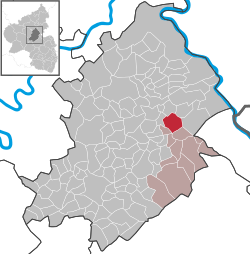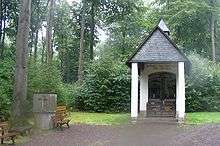Kisselbach
| Kisselbach | ||
|---|---|---|
| ||
 Kisselbach | ||
Location of Kisselbach within Rhein-Hunsrück-Kreis district  | ||
| Coordinates: 50°03′08″N 7°36′38″E / 50.05222°N 7.61056°ECoordinates: 50°03′08″N 7°36′38″E / 50.05222°N 7.61056°E | ||
| Country | Germany | |
| State | Rhineland-Palatinate | |
| District | Rhein-Hunsrück-Kreis | |
| Municipal assoc. | Rheinböllen | |
| Government | ||
| • Mayor | Heinz-Ludwig Kub (CDU) | |
| Area | ||
| • Total | 9.13 km2 (3.53 sq mi) | |
| Population (2013-12-31)[1] | ||
| • Total | 586 | |
| • Density | 64/km2 (170/sq mi) | |
| Time zone | CET/CEST (UTC+1/+2) | |
| Postal codes | 56291 | |
| Dialling codes | 06766 | |
| Vehicle registration | SIM | |
| Website |
www | |


Kisselbach is an Ortsgemeinde – a municipality belonging to a Verbandsgemeinde, a kind of collective municipality – in the Rhein-Hunsrück-Kreis (district) in Rhineland-Palatinate, Germany. It belongs to the Verbandsgemeinde of Rheinböllen, whose seat is in the like-named town.
Geography
Location
The municipality lies in the eastern Hunsrück at the foot of the Soonwald, a heavily wooded section of the Hunsrück, and some 15 km from the Rhine. The Simmerbach flows through the village. Kisselbach is the northernmost municipality in the Verbandsgemeinde of Rheinböllen.
History
In 1240, Kisselbach had its first documentary mention and from times of yore it was split by the Simmerbach into two like-named villages, one of which belonged to the Archbishopric of Trier while the other was held by Electoral Palatinate. Beginning in 1794, both villages lay under French rule. In 1814 they were assigned to the Kingdom of Prussia at the Congress of Vienna. The separate administration, however, continued, and only in 1939 were the two municipalities united into a single one. Since 1946, it has been part of the then newly founded state of Rhineland-Palatinate.
Population development
The table lists population figures for Kisselbach from selected years since the Congress of Vienna (at 31 December each time):[2]
| Historical population | ||||||||||||||||||||||||||||||||||||||||||||||||||||||||||||||||||||
|---|---|---|---|---|---|---|---|---|---|---|---|---|---|---|---|---|---|---|---|---|---|---|---|---|---|---|---|---|---|---|---|---|---|---|---|---|---|---|---|---|---|---|---|---|---|---|---|---|---|---|---|---|---|---|---|---|---|---|---|---|---|---|---|---|---|---|---|---|
|
|
| ||||||||||||||||||||||||||||||||||||||||||||||||||||||||||||||||||
Politics
Municipal council
The council is made up of 12 council members, who were elected by majority vote at the municipal election held on 7 June 2009, and the honorary mayor as chairman.[3]
Mayor
Kisselbach’s mayor is Heinz-Ludwig Kub, and his deputies are Winfried Acht and Rosi Müller.[4]
Coat of arms
The German blazon reads: Unter goldenem Schildhaupt, darin ein rotbewehrter, schwarzer Adler, schräglinke Wellenteilung. Vorne in Schwarz ein goldener, rotgezungter und bewehrter Löwe nach links, hinten rotes Balkenkreuz in Silber.
The municipality’s arms might in English heraldic language be described thus: Per bend sinister wavy sable a lion rampant sinister Or armed and langued gules and argent a cross of the third, on a chief of the second an eagle displayed of the first armed of the third.
The black eagle in the chief recalls the Imperial immediacy formerly held by “Königs-Kisselbach” (“King’s Kisselbach”). The wavy line of partition symbolizes the Simmerbach, which divided what was once two villages, both named Kisselbach: Diesseits (roughly “On This Side” or “Over Here”), as the Electoral-Palatinate side was called, is represented by the Palatine Lion on the dexter (armsbearer’s right, viewer’s left) side, while Jenseits (roughly “On That Side” or “Over There”), as the Electoral-Trier side was called, is represented by the Trier cross on the sinister (armsbearer’s left, viewer’s right) side.[5]
Culture and sightseeing
Buildings
The following are listed buildings or sites in Rhineland-Palatinate’s Directory of Cultural Monuments:[6]
- Saint Apollonia’s Catholic Church (St.-Apollonia-Kirche), Liebshausener Straße – originally three-naved, now one-naved Gothic Revival column basilica, after 1912; whole complex of buildings with graveyard
Other buildings
Another building worth seeing in Kisselbach is the Waldkapelle (“Forest Chapel”) consecrated to Mary, to which a procession of lights is made on the 13th day of every month from May to October by the local Catholic congregation.
Clubs
In Kisselbach there are a sport club with a tennis department, a volunteer fire brigade, a theatrical club and the Catholic church’s singing club. As well, Kisselbach has at its disposal its own open channel.
Economy and infrastructure
Transport
Kisselbach lies near the Autobahn A 61, Laudert/Kisselbach interchange.
References
- ↑ "Gemeinden in Deutschland mit Bevölkerung am 31. Dezember 2013". Statistisches Bundesamt (in German). 2014.
- ↑ Statistisches Landesamt Rheinland-Pfalz
- ↑ Municipal election results for Kisselbach
- ↑ Kisselbach’s council
- ↑ Description and explanation of Kisselbach’s arms
- ↑ Directory of Cultural Monuments in Rhein-Hunsrück district
External links
- Municipality’s official webpage (German)
|
